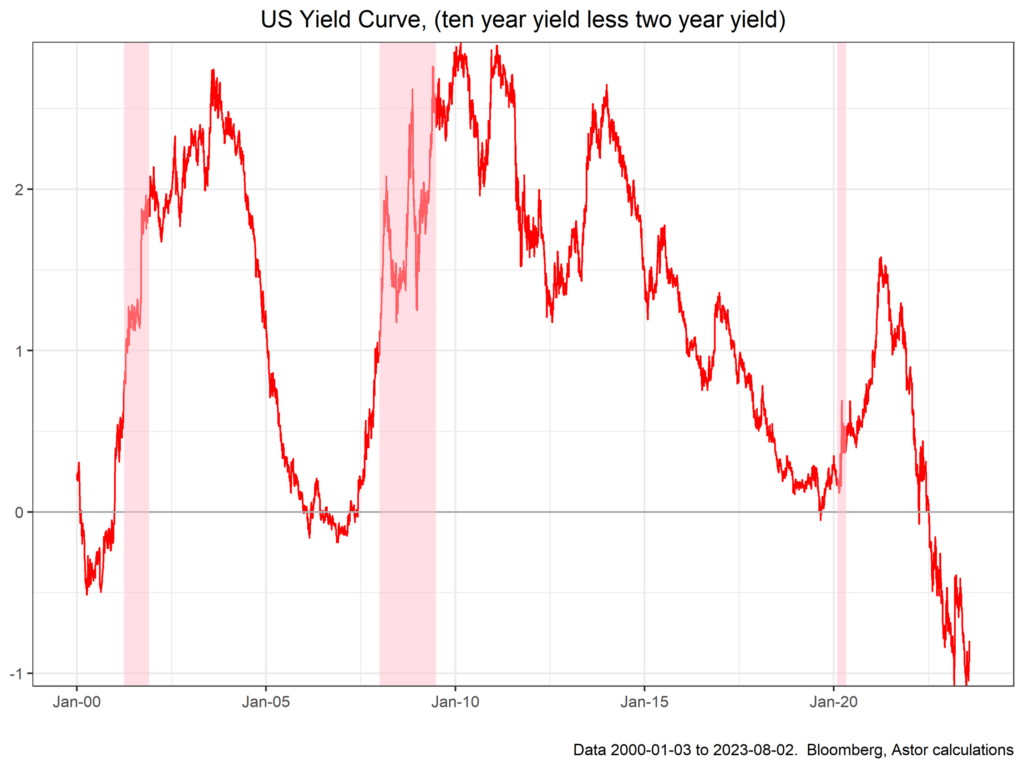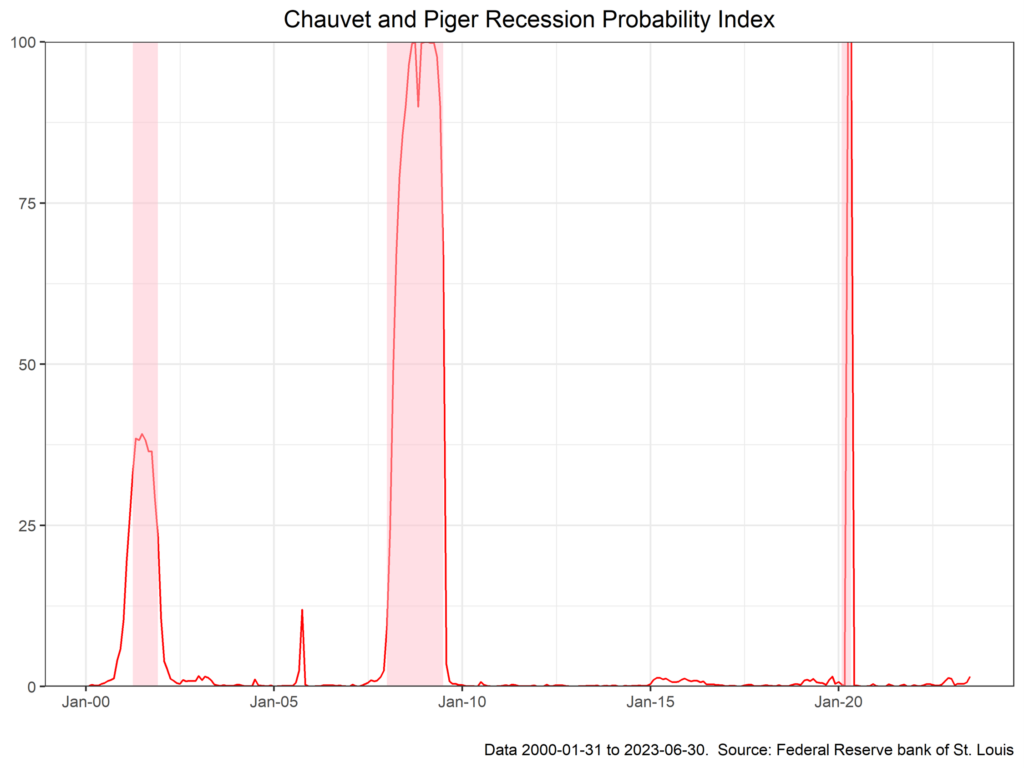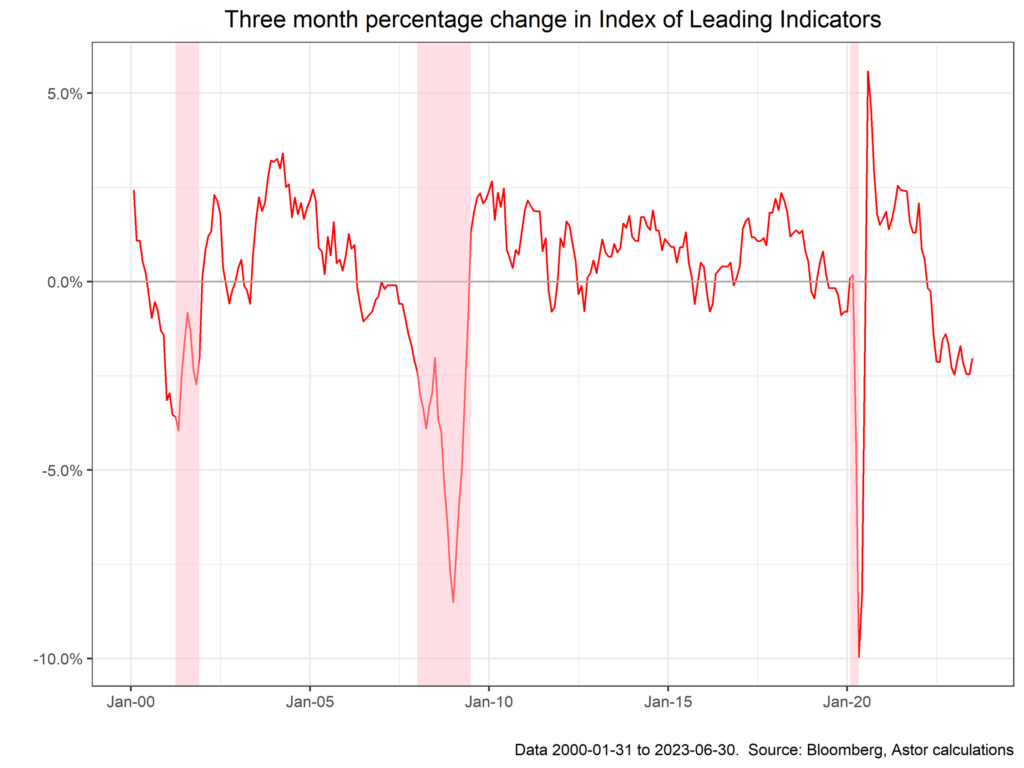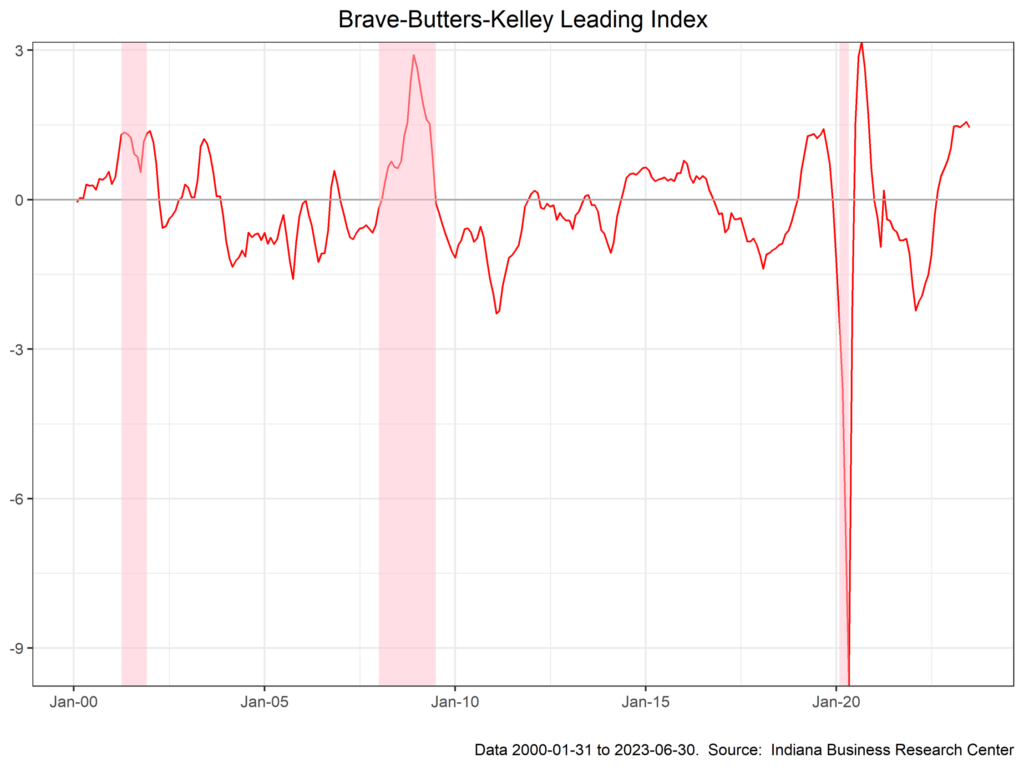If I tell a stranger, you are an economist the first thing you notice is the glassy look in their eyes. The second thing that happens is that they ask you what will happen to the stock market. Economists don’t know! We can echo Pierpont Morgan and say, “I expect it to fluctuate”, but beyond that it’s tricky. The third thing is that they ask if we will have a recession soon. Economists, diligent social scientists that they are, have come up with a wide range of tools to answer this question.
Let’s check in with them now and see if we have a recession in our future. The indicator with, I believe, the greatest mindshare is the steepness of the term structure, that is the yield of the ten-year government bond less the two year government bond.

The signal is that recessions follow periods when the short term yield is higher than the long term yield, in other words the yield curve is inverted. Short term rates are much more sensitive to the Fed Funds rate so one plausible interpretation of the inverted yield curve is that it corresponds to periods where the Fed has raised short term rates enough to constrain economic growth.
According to this indicator the economy is nearly certain to be entering a recession soon. The yield curve is extremely inverted and has been for more than a year. Beyond the yield curve, there are several methods which look for leading economic data to divine the future of the economy. At one extreme is the Chauvet and Piger Recession Probability Index1 which selects four series as the foundation of its recession probability model. Here there is no recession coming.

Source: Federal Reserve Bank of St. Louis, Chauvet, Marcelle; Piger, Jeremy Max. Data range: 01-31-2000 to 06-30-20232
An index familiar to many is the US Leading Indicators which is designed by the Conference Board to “[provide] an early indication of significant turning points in the business cycle and where the economy is heading in the near term.” The composition and calculation of this index has changed over time. It currently has 11 indicators, mainly economic though some are financial (such as the steepness of the terms structure, for example.)

The LEI has declined for the last 15 months and the Conference Board, which publishes it expects a recession this fall. Another economic approach is to just take many economic series and let the computer figure it out for itself. This is the approach taken by the Brave-Butters-Kelley3 Indexes (BBK) which uses about 500 indicators to make leading and coincident indicators. The BBK index tipped into “recession soon” territory last year, though poorly documented revisions make it tricky to give the exact dates. The leading index has since moved to strongly positive territory. No matter what happens in the next 12 months they can claim success!

In short, you can find empirical justification now for every view the term structure and the LEI are forecasting recessions. The Chauvet and Piger index is sounding all clear and BBK has had both boom-and-bust signals in the last year. This brings us around to Astor philosophy. At Astor we believe that it is impossible to predict recessions because if they were predictable, they could be avoided. Knowing a recession was coming the Fed and the government would try to cushion the blow. Businesses and individuals would adjust spending plans. This might increase the short-term odds of a recession if they increased savings but would also have money on the sidelines ready to snap up bargains and limit any adjustment they would have to make.
Our Astor Economic Index® (AEI) tries to answer the question: are we in a recession today, sometimes called “nowcasting”. Our index is indicating caution right now. The AEI is currently somewhere between the extremes described above: it sees growth in the U.S. economy as somewhat below trend hence our judgement that our equity market exposure should be modest today.
Endnotes
1. www.alfred.stlouisfed.org. Smoothed recession probabilities for the United States are obtained from a dynamic-factor markov-switching model applied to four monthly coincident variables: non-farm payroll employment, the index of industrial production, real personal income excluding transfer payments, and real manufacturing and trade sales.
2. www.jeremypiger.com. Chauvet, M. and J. Piger, “A Comparison of the Real-Time Performance of Business Cycle Dating Methods,” Journal of Business and EconomicStatistics, 2008.
3. www.ibrc.indiana.edu/bbki/. This data set summarizes 490 macroeconomic time series extending back to 1960 to generate a coincident index that provides a snapshot of the current state of the economy, a leading index that looks toward the future, and monthly gross domestic product (GDP) growth estimates.
Astor Investment Management LLC is a registered investment adviser with the SEC. All information contained herein is for informational purposes only. This is not a solicitation to offer investment advice or services in any state where to do so would be unlawful. Analysis and research are provided for informational purposes only, not for trading or investing purposes. All opinions expressed are as of the date of publication and subject to change. They are not intended as investment recommendations. These materials contain general information and have not been tailored for any specific recipient. There is no assurance that Astor’s investment programs will produce profitable returns or that any account will have similar results. You may lose money. Past results are no guarantee of future results. Please refer to Astor’s Form ADV Part 2A Brochure for additional information regarding fees, risks, and services.
The Astor Economic Index®: The Astor Economic Index® is a proprietary index created by Astor Investment Management LLC. It represents an aggregation of various economic data points. The Astor Economic Index® is designed to track the varying levels of growth within the U.S. economy by analyzing current trends against historical data. The Astor Economic Index® is not an investable product. The Astor Economic Index® should not be used as the sole determining factor for your investment decisions. The Index is based on retroactive data points and may be subject to hindsight bias. There is no guarantee the Index will produce the same results in the future. All conclusions are those of Astor and are subject to change. Astor Economic Index® is a registered trademark of Astor Investment Management LLC.
MAS-M-418202-2023-08-21